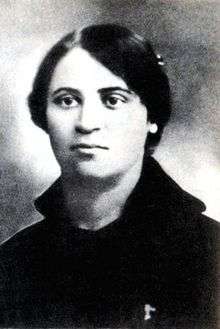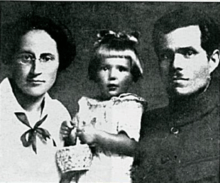Halyna Kouzmenko
Agafya "Halyna" or "Galina" Andreyevna Kuzmenko Makhno (Ukrainian: Галина Андріївна Кузьменко, Russian: Агафья (Галина) Андреевна Кузьменко; 1896–1978) was a Ukrainian teacher and anarchist, and the wife of Nestor Makhno.[1]
Agafya Andreyevna Kuzmenko | |
|---|---|
 | |
| Born | 1896 |
| Died | 1978 (aged 81–82) |
| Occupation | Anarchist revolutionary Teacher |
Biography

Halyna Kuzmenko was, according to most sources, born in 1896 in Kiev in what was then the Russian Empire.[2] After her birth, her parents moved to the village of Pichtchany Brid in the Yekaterinoslav Governorate, in what is now Kirovohrad Oblast in central Ukraine. Other sources claim that she was born in 1892,[3] in Pichtchany Brid.[4] Her father, a former farmer, worked as a policeman.[2][3]
During her higher education, she attended the teachers' seminar in Kiev, and became a teacher in 1916.[2] She taught Ukrainian language and literature[3] in the town of Huliaipole (also spelled 'Gulyai-Pole' and variants). She became well known as a Ukrainian anarchist and patriot and as an active local activist of the Prosvita.[2][3] In early 1919, Halyna Kuzmenko married Nestor Makhno, who at the time was leading the forces of the Free Territory against the invading Russian Red Army as the Russian Civil War came to Ukraine.[5] She was described by Viktor Belash, Chief of Staff of the Revolutionary Insurrectionary Army of Ukraine, as a tireless advocate for women and their education.[6] In the fall of 1919, she was elected president of the Union of Teachers.[3]
During the Makhnovist retreat from their positions at the same time, the Nabat was temporarily replaced with a group of Ukrainian national anarchists, whose viewpoints won Kuzmenko over. She continued to espouse their ideology until 1922.[7] Directly connected by authors such as Ibid Teper to Symon Petliura, he also drew the conclusion that this group was at least partially responsible for the rise in antisemitic violence within the ranks of the Insurrectionary Army at the same time.[8]
Other sources mention her as part of a partially hidden conspiracy, aimed at removing Makhno from his position of power, and merging the Petliurist Army of the UNR with the Insurrectionary Army, in order to fight together against both the White and the Red Army.[9] This never came to a reality, as the popularity of the movement significantly decreased following the revelation of documents collected by the kontrrozvidka, the Makhnovist secret police. These documents contained definitive proof that Petliura had been negotiating with high-ranking officers of the white movement, most notably Anton Denikin, in order to ally against both the Red and the Insurgent armies.[7]
In August 1921, following the fall of the Free Territory, Makhno and Kuzmenko fled to Romania, from which they moved to Poland.[10] Their daughter, Yelena, was born in 1922. On 25 September 1923, they were arrested by the Polish authorities, being accused by two members of the Ukrainian Insurgent Army of preparing an insurrection in Galicia for the construction of an anarchist-communist society together with the Cheka.[2] Kuzmenko and Makhno were both acquitted, and in 1924, the pair went first to Germany and then to Paris in 1926. For almost 10 years, they lived a relatively peaceful life in Vincennes. Slowly but surely, the health of Nestor Makhno started to decline. The couple survived on the salary of Halyna, a worker in a shoe factory in Paris, and the help of other anarchist comrades.[1]
Following the death of Nestor Makhno in 1934, Halyna Kuzmenko began to contact family and friends back in what was now the Ukrainian Soviet Socialist Republic, in order to return to the USSR.[2] During her working-time in Paris, as a librarian in the Slavic Department of the Bibliothèque nationale de France, she collaborated with the secret services, transmitting information to the USSR.[2]
During the Second World War and the German occupation, Yelena was sent to Germany under the Service du travail obligatoire, where she worked in a Siemens factory. Halyna Kuzmenko followed her, and chose to stay with her in Germany, waiting with her plans to move to the USSR.[1]
In August 1945, as new identity documents were being issued for them, Yelena and Halyna were arrested by the Soviet authorities. The two were sent to Kiev, where, in July 1946, Halyna Kuzmenko was sentenced to 8 years in prison having participated in the Ukrainian insurrection, being sentenced on counts of counterrevolutionary activity.[2] Yelena was sentenced to 5 years in prison for collaboration with the German occupying forces.[2] The trial was not made public. Imprisoned in Doubravlag camp, Halyna was released following the amnesty of 1954, or, according to other sources, in 1963. Following her release, she continued to live with her daughter, moving to the city of Djambul, today Taraz, Kazakhstan. She went several times to Gulyai-Polye to see her relatives. In 1977, Galina petitioned the Presidium of the Supreme Soviet with a complaint about the persecution at work of Elena Nesterovna.[1][2]
Halyna died in Taraz on 23 March 1978 at the age of 81.[2]
Education system foundation
Galina Kuzmenko was the president of the Teachers' Union of Makhnovia, a position she held from 1919 to its de facto abolishment with the fall of the Free Territory. It was during this period that a new way of education was organized in Gulyai-Polye. This new system was, in contrast to the heavily religious and state-driven Imperial Russian school system, based on anarchist ideals and a divorcing of education from religion.[3] Her actions there were focused on the funding the activities, organizing the education in the border territories controlled by the Makhnovists, the management of schools by joint teacher-parent councils, and the development of new school curricula.[11]
The inspiration for the system that was implemented in the Free Territory was presented in a pamphlet of the Spanish libertarian pedagogue Francisco Ferrer,[3] whose theories about creating a school system free from the influence of the state was heavily influential throughout the international anarchist movement. Before the military defeat of the anarchists, the system was generally well-received by peasants, teachers, and the children alike, mainly because of the efforts made to feed the often poor school-children.[3]
Controversy around Forty Days in Gulyai-Polye
Forty Days in Gulyai-Polie was an article published in 1919. Presenting its author as Galina Kuzmenko, it shows Nestor Makhno as a drunkard and the leader of a "mad and wild horde", engaging in systematic abuses against the peasants of Ukraine, as well as against her.[12] The authenticity of the document has been debated at length, with some considering it a forgery committed by Soviet propaganda services.[2][12] Possible alternative theories, along the one of Cheka fabrication, is that the book was written by a teacher from Kostiantynivka, Feodora Gayenko, who worked together with Galina in noting the crimes committed by the Insurrectionary forces in Ukraine during the time of the Free Territory. Others have stated their belief that the diary is authentic, including Galina and Nestor's daughter and the director of the Gulyai-Pole Museum.[13]
The theory that Gayenko faked it supposes that she (Gayenko) was not killed but was captured, and after time and pressure, collaborated with the Cheka, at least during early 1921 and onwards, when she was finally convinced of the downfall of the Makhnovist movement.[12] This theory is supported by the propaganda organs of the Red Army only referring as the book as the "Diary of Makhno's Wife" from this point onwards, but also disproves most, if not all, credibility the book has as an argument against the Free Territory, as the Cheka would have had free access to censor the book and fabricate details as they wished.[12] V. N. Litvinov defends Makhno in the following text, originally published in the journal Obshchina (Russian: Община, Society), published by the Confederation of Anarcho-Syndicalists in Moscow:
It's quite possible that some entries of the "Diary" actually reflect real facts about the Makhnovist terror but one must acknowledge that under contemporary conditions of source study it is practically impossible to determine which of the entries are genuine. But even if it were possible to do so, there is no doubt that the diary entries depict Makhnovist terror with an extraordinarily biased slant because the entries completely ignore the practice of Red Terror in the insurgent region.[2]
References
- "MAKHNO Nestor [Nestor Ivanovitch Mikhnienko, dit] [Dictionnaire des (...) - Maitron". maitron-en-ligne.univ-paris1.fr (in French). Retrieved 2019-10-03.
- "An unsolved mystery: the "diary of Makhno's wife" - V.N. Litvinov". libcom.org. Retrieved 2019-10-03.
- Tchop, V.M. "Галина Андріївна Кузьменко – голова Союзу вчителів Гуляйпільської республіки (1919-1920 рр.)" [Galina Andriivna Kuzmenko - leader of the Teachers' Union of the Republic of Gulyai-Polie]. Історія і культура Придніпров'я. 1: 128–134.
- "RUTHENOS". pavlogradruth.narod.ru. Retrieved 2019-10-03.
- Skirda, Alexandre (1982). Nestor Makhno, le Cosaque de l'anarchie: la lutte pour les soviets libres en Ukraine, 1917-1921 (in French). A. Skirda.
- Белаш, Александр Викторович. (1993). Дороги Нестора Махно : историческое повествование. РВЦ "Проза". ISBN 5770738146. OCLC 429142607.
- Azarov, Vyacheslav (October 2007). Kontrrazvedka - The Story of the Makhnovist Intelligence Service (PDF). Black Cat Press. ISBN 978-0-9737827-2-1.
- Teper, Ibid (1924). От "едіноґо анаркгізма" к стопам руминскоґо короліа [Makhno: from a "United anarchism" to the Feet of the Romanian King]. Moscow.
- Chop, V. Цоиуз і Змова [Alliance and Accord].
- Anselme, Louise (2017-03-31). Cinémas libertaires: Au service des forces de transgression et de révolte (in French). Presses Universitaires du Septentrion. ISBN 9782757414415.
- Avrich, Paul. (1973). The Anarchists in the Russian Revolution. p. 267. OCLC 464080752.
- "Une investigation confuse et lacunaire sur Makhno - [A Contretemps, Bulletin bibliographique]". acontretemps.org (in French). Retrieved 2019-10-03.
- Patterson, Sean David (2013). The Makhnos of memory: Mennonite and Makhnovist narratives of the Russian Civil War, 1917-1921 (PDF). University of Manitoba: MA thesis. pp. 35, 171. Retrieved 10 November 2019.
